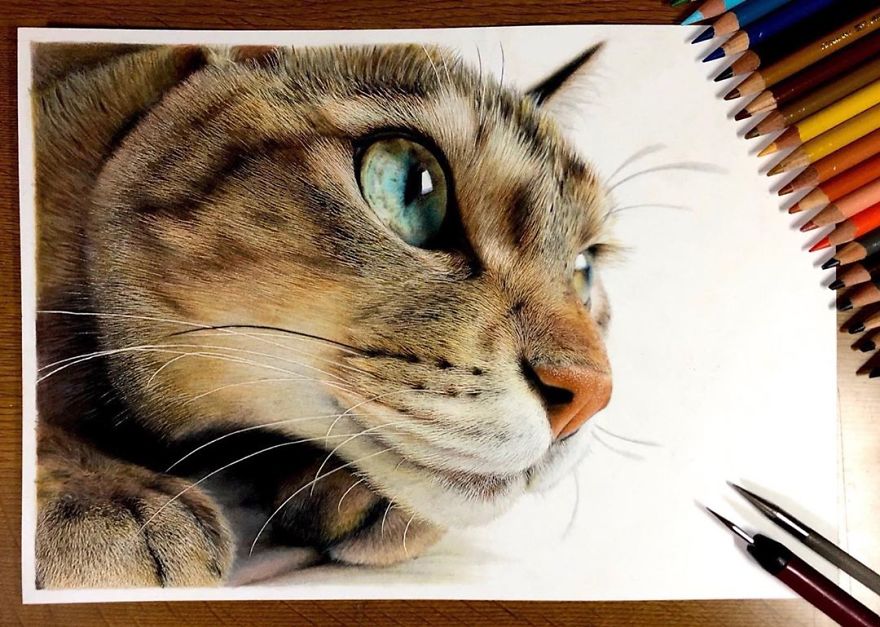Currently Empty: $0.00

Unleash Your Creative Paws: A Comprehensive Tutorial for Mastering Cat Drawing
Table of Contents
Are you a budding artist with a fondness for felines? If so, you’ve come to the purrfect place! Welcome to our step-by-step guide on how to draw a realistic cat that will leave you feline fantastic about your artistic abilities. Whether you’re a seasoned sketcher or just starting your creative journey, this guide will help you capture the essence of our furry friends on paper. So grab your pencils, find a cozy spot, and let’s dive into the mesmerizing world of cat drawing!
Table of Contents
- Introduction to Cat Drawing
- Gathering Your Art Supplies
- Understanding Cat Anatomy
- Sketching the Basic Cat Shape
- Adding Life to the Eyes and Ears
- Detailing the Fur and Whiskers
- Creating Realistic Textures
- Finalizing Your Cat Drawing
1. Introduction to Cat Drawing
Drawing cats can be both a relaxing and rewarding experience. Cats, with their graceful movements and captivating expressions, have been a subject of artistic admiration for centuries. In this guide, we’ll walk you through the process of creating a lifelike cat drawing that captures their unique personality.
2. Gathering Your Art Supplies
Before we embark on our creative journey, it’s essential to have the right tools by your side. To bring your cat drawing to life, you’ll need:
- Drawing Paper: Choose a high-quality, acid-free paper that’s suitable for your preferred drawing medium.
- Pencils: A range of pencils from 2H to 6B will help you achieve varying tones and depths.
- Eraser: An eraser will come in handy for correcting mistakes and refining details.
- Blending Tools: Blending stumps or your fingers can be used to smooth out shading and create a more realistic look.
- Reference Image: Select a clear, high-resolution image of a cat that you’d like to draw inspiration from.
3. Understanding Cat Anatomy
To draw a cat convincingly, it’s crucial to understand their anatomy. Study different cat breeds to grasp variations in body shapes, ear sizes, and tail lengths. Pay close attention to the proportions of their head, body, and limbs. This understanding will form the foundation of your realistic cat drawing.
4. Sketching the Basic Cat Shape
Start with a light pencil outline of the cat’s basic shape. Begin by drawing a circle for the head and an oval for the body. Remember, this is just the framework, so don’t worry about perfection at this stage.
5. Adding Life to the Eyes and Ears
The eyes are said to be the windows to the soul, and for cats, they hold a world of expression. Carefully draw the eyes, keeping the proportions and shapes accurate. Move on to the ears, noting their placement and structure. These features will bring life and personality to your cat drawing.
6. Detailing the Fur and Whiskers
Fur is one of the most challenging aspects of cat drawing, but fear not! Use light, short strokes to gradually build up the texture of the fur. Take breaks to observe your reference image and replicate the direction of the fur growth. Add intricate details like whiskers for that extra touch of realism.
7. Creating Realistic Textures
Textures like soft fur, shiny eyes, and a wet nose can take your cat drawing to the next level. Experiment with different shading techniques to capture these textures. Hatching, cross-hatching, and blending can all contribute to the tactile quality of your artwork.
8. Finalizing Your Cat Drawing
Step back and assess your drawing as a whole. Make any necessary adjustments to proportions, tones, and details. Once you’re satisfied, darken the lines you want to keep and erase any remaining guidelines. Congratulations – you’ve just completed a realistic cat drawing that’s sure to impress!
High Authority Outbound Links
For more inspiration and tips on mastering the art of drawing animals, consider exploring these authoritative resources:
- National Geographic Kids: Discover a treasure trove of information about various animal species, including cats, to enhance your understanding of their anatomy and behavior.
- The Metropolitan Museum of Art: Delve into the art world’s history with a wide range of artworks, including stunning depictions of cats, to gain insights into different artistic styles and techniques.
FAQs about Cat Drawing
Q1: Do I need to be an experienced artist to follow this guide?
A: Not at all! This guide is designed to help artists of all skill levels, from beginners to advanced, improve their cat drawing abilities.
Q2: Can I use a reference image from the internet?
A: Absolutely. Using a clear reference image is highly recommended to ensure the accuracy and realism of your cat drawing.
Q3: How long does it take to become proficient at drawing cats?
A: The learning curve varies from person to person. With practice, patience, and dedication, you’ll notice significant improvements over time.
Q4: Are there specific cat breeds that are easier to draw for beginners?
A: Some simpler cat breeds like the British Shorthair or the Maine Coon can be a good starting point due to their distinct features and shapes.
In Conclusion
Embarking on the journey of cat drawing can be incredibly fulfilling. With the right techniques, tools, and practice, you’ll soon be creating stunningly realistic feline artworks that capture the essence of these captivating creatures. So, what are you waiting for? Grab your pencils and start sketching your way to feline artistry!

